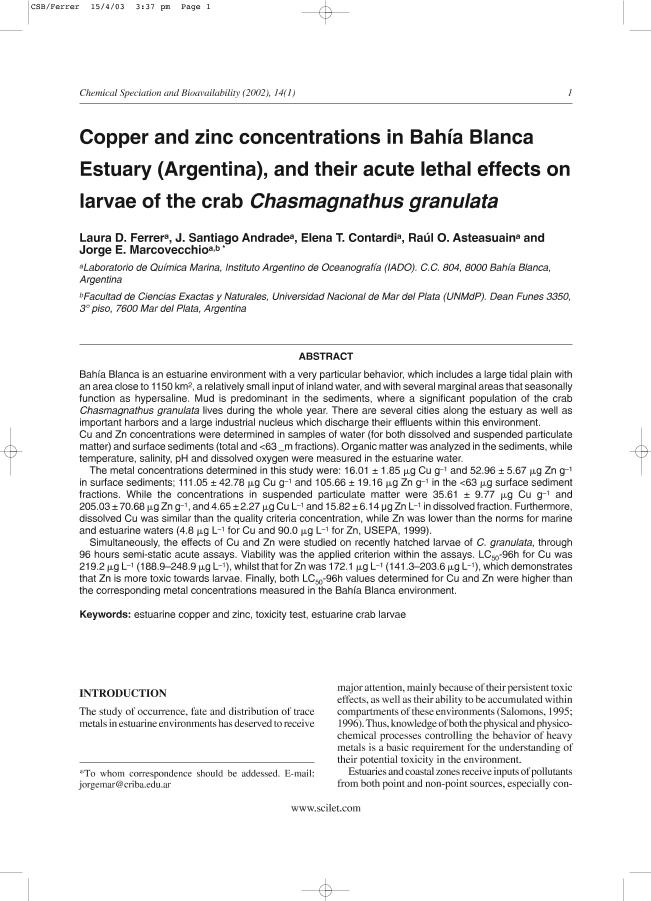Mostrar el registro sencillo del ítem
dc.contributor.author
Ferrer, Laura Daniela

dc.contributor.author
Andrade, Santiago

dc.contributor.author
Contardi, Elena Teresa

dc.contributor.author
Asteasuain, Raul Oscar

dc.contributor.author
Marcovecchio, Jorge Eduardo

dc.date.available
2018-01-29T14:55:12Z
dc.date.issued
2002-10
dc.identifier.citation
Ferrer, Laura Daniela; Andrade, Santiago; Contardi, Elena Teresa; Asteasuain, Raul Oscar; Marcovecchio, Jorge Eduardo; Copper and zinc concentrations in Bahía Blanca estuary (Argentina), and their acute lethal effects on larvae of the crab Chasmagnathus granulata; Taylor & Francis; Chemical Speciation And Bioavailability; 15; 1; 10-2002; 7-14
dc.identifier.issn
0954-2299
dc.identifier.uri
http://hdl.handle.net/11336/34844
dc.description.abstract
Bahía Blanca is an estuarine environment with a very particular behavior, which includes a large tidal plain with an area close to 1150 km2, a relatively small input of inland water, and with several marginal areas that seasonally function as hypersaline. Mud is predominant in the sediments, where a significant population of the crab Chasmagnathus granulata lives during the whole year. There are several cities along the estuary as well as important harbors and a large industrial nucleus which discharge their effluents within this environment. Cu and Zn concentrations were determined in samples of water (for both dissolved and suspended particulate matter) and surface sediments (total and <63 _m fractions). Organic matter was analyzed in the sediments, while temperature, salinity, pH and dissolved oxygen were measured in the estuarine water. The metal concentrations determined in this study were: 16.01 ± 1.85 g Cu g–1 and 52.96 ± 5.67 g Zn g–1 in surface sediments; 111.05 ± 42.78 g Cu g–1 and 105.66 ± 19.16 g Zn g–1 in the <63 g surface sediment fractions. While the concentrations in suspended particulate matter were 35.61 ± 9.77 g Cu g–1 and 205.03 ± 70.68 g Zn g–1, and 4.65 ± 2.27 g Cu L–1 and 15.82 ± 6.14 μg Zn L–1 in dissolved fraction. Furthermore, dissolved Cu was similar than the quality criteria concentration, while Zn was lower than the norms for marine and estuarine waters (4.8 g L–1 for Cu and 90.0 g L–1 for Zn, USEPA, 1999). Simultaneously, the effects of Cu and Zn were studied on recently hatched larvae of C. granulata, through 96 hours semi-static acute assays. Viability was the applied criterion within the assays. LC50-96h for Cu was 219.2 g L–1 (188.9–248.9 g L–1), whilst that for Zn was 172.1 g L–1 (141.3–203.6 g L–1), which demonstrates that Zn is more toxic towards larvae. Finally, both LC50-96h values determined for Cu and Zn were higher than the corresponding metal concentrations measured in the Bahía Blanca environment.
dc.format
application/pdf
dc.language.iso
eng
dc.publisher
Taylor & Francis

dc.rights
info:eu-repo/semantics/openAccess
dc.rights.uri
https://creativecommons.org/licenses/by-nc/2.5/ar/
dc.subject
Estuario de Bahia Blanca
dc.subject
Metales Traza
dc.subject
Bioindicador
dc.subject
Cangrejo Cavador
dc.subject.classification
Meteorología y Ciencias Atmosféricas

dc.subject.classification
Ciencias de la Tierra y relacionadas con el Medio Ambiente

dc.subject.classification
CIENCIAS NATURALES Y EXACTAS

dc.title
Copper and zinc concentrations in Bahía Blanca estuary (Argentina), and their acute lethal effects on larvae of the crab Chasmagnathus granulata
dc.type
info:eu-repo/semantics/article
dc.type
info:ar-repo/semantics/artículo
dc.type
info:eu-repo/semantics/publishedVersion
dc.date.updated
2017-12-12T19:35:10Z
dc.identifier.eissn
2047-6523
dc.journal.volume
15
dc.journal.number
1
dc.journal.pagination
7-14
dc.journal.pais
Reino Unido

dc.journal.ciudad
Londres
dc.description.fil
Fil: Ferrer, Laura Daniela. Consejo Nacional de Investigaciones Científicas y Técnicas. Centro Científico Tecnológico Conicet - Bahía Blanca. Instituto Argentino de Oceanografía. Universidad Nacional del Sur. Instituto Argentino de Oceanografía; Argentina
dc.description.fil
Fil: Andrade, Santiago. Consejo Nacional de Investigaciones Científicas y Técnicas. Centro Científico Tecnológico Conicet - Bahía Blanca. Instituto Argentino de Oceanografía. Universidad Nacional del Sur. Instituto Argentino de Oceanografía; Argentina
dc.description.fil
Fil: Contardi, Elena Teresa. Consejo Nacional de Investigaciones Científicas y Técnicas. Centro Científico Tecnológico Conicet - Bahía Blanca. Instituto Argentino de Oceanografía. Universidad Nacional del Sur. Instituto Argentino de Oceanografía; Argentina
dc.description.fil
Fil: Asteasuain, Raul Oscar. Consejo Nacional de Investigaciones Científicas y Técnicas. Centro Científico Tecnológico Conicet - Bahía Blanca. Instituto Argentino de Oceanografía. Universidad Nacional del Sur. Instituto Argentino de Oceanografía; Argentina
dc.description.fil
Fil: Marcovecchio, Jorge Eduardo. Consejo Nacional de Investigaciones Científicas y Técnicas. Centro Científico Tecnológico Conicet - Bahía Blanca. Instituto Argentino de Oceanografía. Universidad Nacional del Sur. Instituto Argentino de Oceanografía; Argentina. Universidad Nacional de Mar del Plata; Argentina
dc.journal.title
Chemical Speciation And Bioavailability

dc.relation.alternativeid
info:eu-repo/semantics/altIdentifier/url/http://www.tandfonline.com/doi/pdf/10.3184/095422903782775271
dc.relation.alternativeid
info:eu-repo/semantics/altIdentifier/doi/https://doi.org/10.3184/095422903782775271
Archivos asociados
